Do you ever feel like your mind is racing at 100 MPH? Making it hard to focus, make decisions, start a project, or finish a task? Would you like relief from your racing thoughts so you can feel less anxious and more relaxed?
If so, then keep reading because I’m going to be sharing 8 simple strategies to help you stop racing thoughts in their tracks. All of these coping techniques are perfect for adults with ADHD (Attention Deficit Hyperactivity Disorder) who simply cannot shut off their minds.
How do adults with ADHD cope with racing thoughts?
“Did I leave the iron on?”
“Did I overshare again?”
“Why did I say that?”
“What should I make for dinner?”
“Am I prepared for tomorrow’s meeting?”
“Oh, Crap! Did I forget to send that birthday card?”
inside the mind of adhd
You feel as if there’s a constant push to think and solve problems, real or anticipated. You find yourself planning for future events, all while thinking of the worst-case scenario that most likely will n-e-v-e-r happen.
You ruminate about that conversation you had yesterday and worry if you said or did the wrong thing.
Then you wonder if you should reach out, stay silent, or you replay the conversation and come up with a million other things you wish you would have said.
Ugh, it feels overwhelming and exhausting just imagining it all!
HOW TO DEAL WITH MENTAL CLUTTER SO YOU CAN FUNCTION
I recently had a client with ADHD share with me that she feels paralyzed by the barrage of anxious thoughts running through her mind.
She feels exhausted from constantly overthinking everything.
It’s affecting her sleep and productivity at work. She asked, “What do I do?”
First off, my mind went “Oh, my goodness do I know exactly how this feels!”
It’s as if multiple conversations are going on in your head all at once.
Your brain just ping pongs between ideas and thoughts and there isn’t a stop button.
Or, you get stuck in an ADHD thought-loop that’s like a Merry-go-Round that you can’t get off.
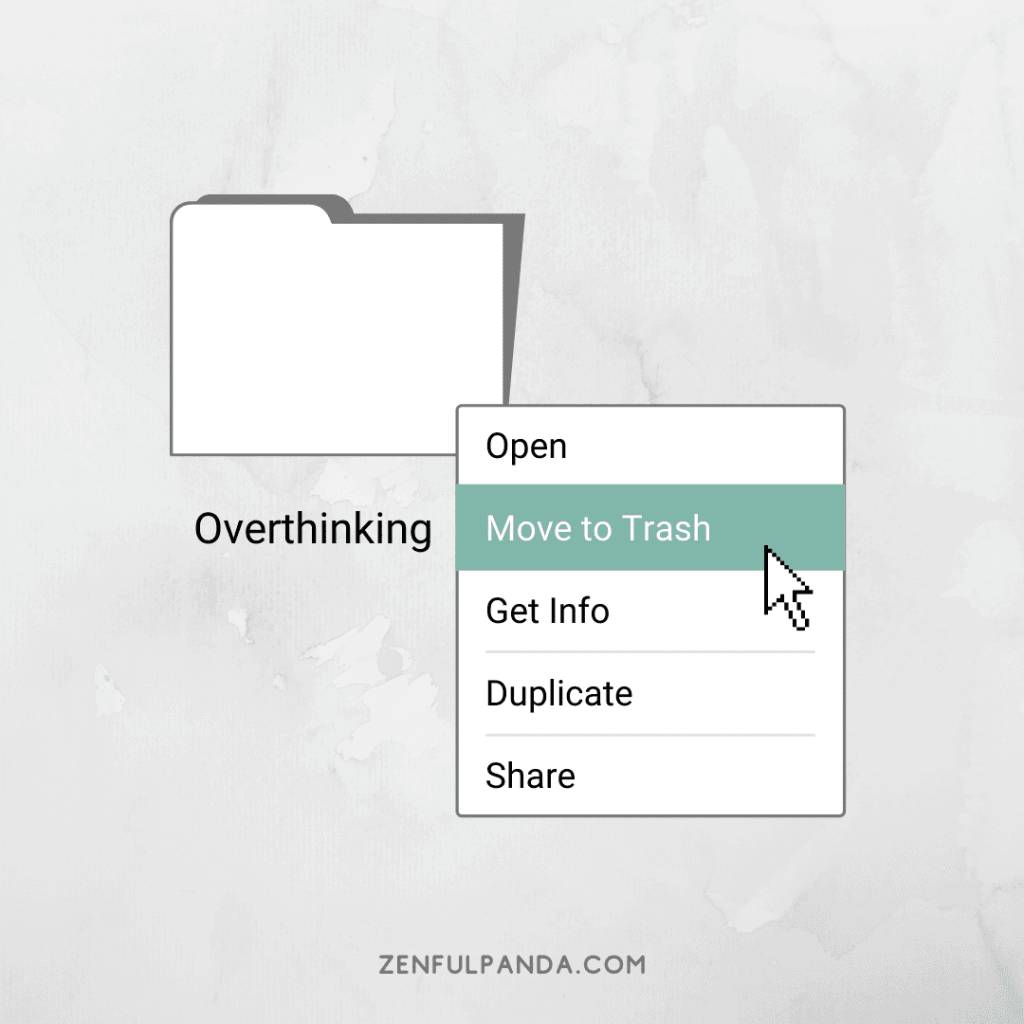
As someone who has attention deficit hyperactivity disorder, I understand how crippling this can be.
So, we chatted about what was causing her racing thoughts and identified some strategies to help her deal with her obsessive thought pattern so she could relax and move forward with a clearer calmer mind.
I wanted to share these mental reset ideas with you in case you find yourself overthinking everything, as well.
I made a little goodie for you and your busy brain ~ Grab your FREE Printable Guide: How to Stop Overthinking So You Can Relax!

Disclaimer: As an Amazon Associate I earn from qualifying purchases. This page contains affiliate links which may reward me in the event of a purchase at not extra cost to you. Thank you for your support.
I’m here to tell you that you deserve a break from all of this unhelpful thinking.
Overthinking about the past won’t change it.
Worrying about the future isn’t helpful either because it robs you of today.
And, if your head is stuck in the past or worrying about the future you can’t truly be present to enjoy the gift that it truly is! (Cliche, yes, but oh so true!)
I’ll be the first to admit that being fully present is much easier said than done. Even for neurotypical brains. But, it’s not impossible for those with ADHD too. It just takes practice and consistency.
Two words my ADHD brain is allergic to – practice and consistency.
But, don’t worry, I’ll break it down so it’s doable.
First, let’s identify when thinking goes from just a little worrying to becoming obsessive or problematic.
WHEN DOES OVERTHINKING BECOME DETRIMENTAL TO YOUR MENTAL HEALTH?
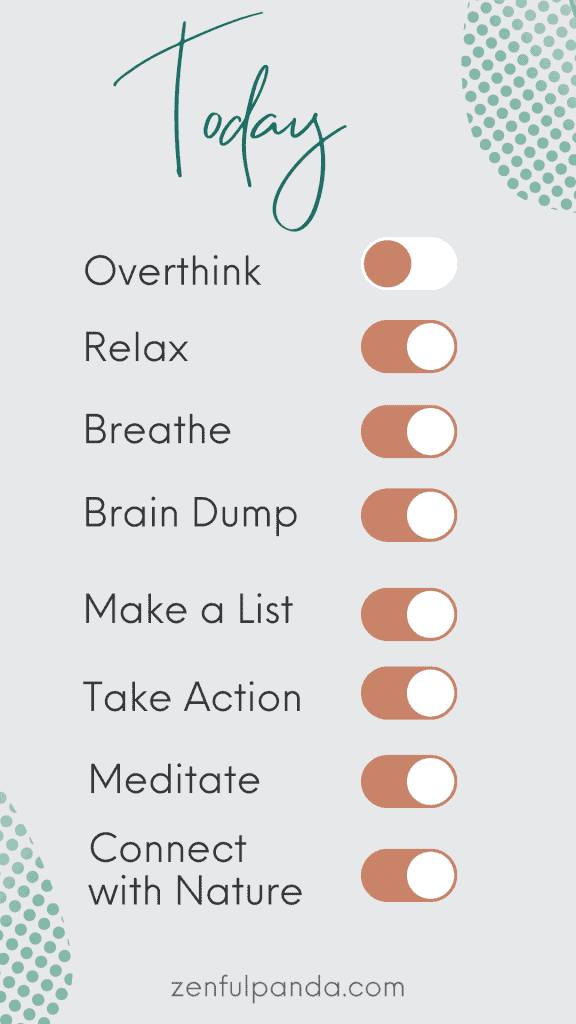
Replaying past events and worrying about the future are both very common behaviors.
Overthinking becomes unhealthy when it begins to interfere with your daily life such as work, family, relationships, eating habits, and sleep, to name a few.
Or, if it paralyzes you from taking action or inhibits you from engaging in life because you’re stuck in your head.
SIGNS YOU’RE AN OVERTHINKER
You have repetitive thoughts and find yourself rehashing the same scenarios in your head over and over again.
You suffer from brain fog or have trouble focusing during the day. At night you stare at the ceiling thinking about situations that happened in the past or you constantly worry about the future.
You’re indecisive and struggle with decision-making. You’re afraid of making the wrong choice so you don’t make any choice at all.
You suffer from analysis paralysis which causes you to remain in the “planning phase”. You have trouble starting a task due to overwhelm, indecision or fear.
TYPES OF OVERTHINKING with ADHD

- Stalling or Procrastination (One of my personal go-to’s)
- Distraction or Avoiding (My toilets are never cleaner than when I have a big project I’m avoiding!)
- Replaying the past over and over (Do you ever replay a conversation from 2 years ago just to come up with the perfect comeback?)
- Getting stuck in a thought-loop
- Constant worry about the future
- Over-Analyzing or Over-Planning to the point of not starting (Yup! Me with a capital “G” Guilty!)
SO, HOW DO YOU STOP OVERTHINKING?
Take a deep breath here because it might get uncomfortable.
You can do this by letting go of control – just for the present moment.
Your brain is incredibly powerful, which means that you can challenge the inner dialog you’re having and change your thought patterns. If you allow it to rest.
But, this all begins by letting go of control. Yes, it may sound counterintuitive and a bit scary, but just entertain the idea for a moment.
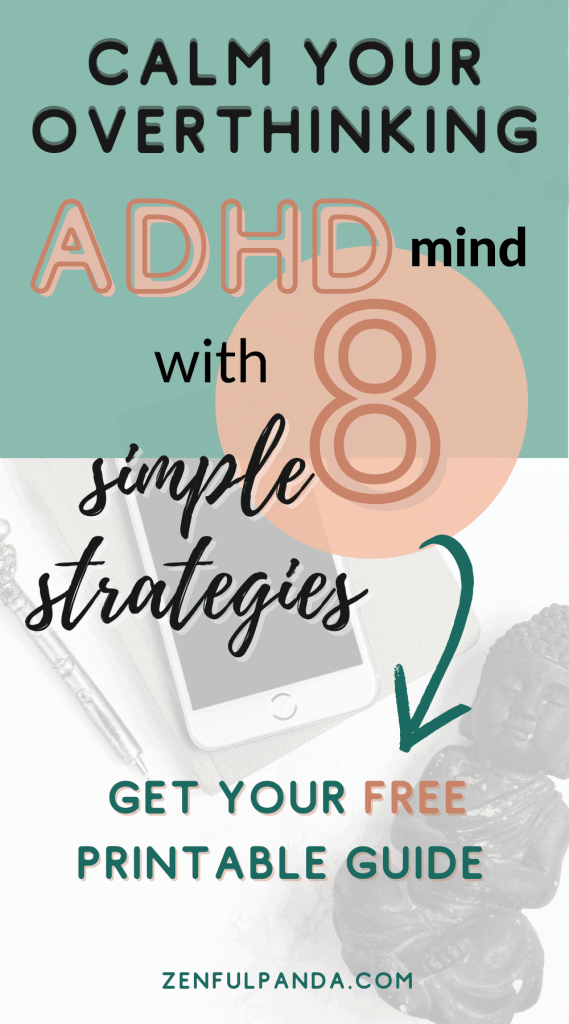
HERE ARE 8 STRATEGIES TO HELP STOP ADHD OVERTHINKING
(psst…They work for those without ADHD too)
1. Self-Massage: A Simple Relaxation Technique to Help Quiet Your Mind
When you’re stressed do you grind your teeth, furrow your brow, or notice tension in your jaw? Teeth grinding, tight muscles, and jaw clenching are all signs of stress in the body.
To relax your mind it helps to relax your body first. Self-massage is a great way to reduce tension in your body.
This simple act of self-care can be done at work, at school, at home, or just about anywhere.
- Jaw – You can begin by releasing the tension in your jaw. Yawn or open your mouth wide for a few seconds. You could also massage your jaw muscles with your fingertips by moving in small circles over the muscle for a few minutes.
- Forehead – Next, try relaxing your forehead. Give yourself a temple massage or just place your hand over your forehead and close your eyes for a few moments to send the signal to your muscles to relax.
- Neck – You can continue this relaxation process by moving down to your neck and rolling it forward and backward and then side to side very slowly and gently. You could even give yourself a little neck massage.
- Shoulders – If you’d like, you can roll your shoulders up and down, and in slow backward circles. Then, take one hand and reach across to the opposite shoulder and give it a nice squeeze up by your neck, moving down your shoulder to the top of your arm, and do the same for your other shoulder.

After you’ve given yourself a relaxing mini massage, sit up nice and straight to help lift your posture. This will allow you to take some nice long deep breaths in and out.
Next is a deep breathing exercise you can do once you’ve relaxed some of the tension in your body.
2. Deep-Breathing Exercise to Help Calm Racing Thoughts
Emotions follow your breath.
If you’re stressed, scared, or anxious you tend to breathe very shallowly and quickly. Your sympathetic nervous system AKA your fight, flight, or freeze response is on full alert.
This is helpful when you’re in a life or death situation or you need to react quickly, but being in a constant state of stress is unhealthy and can wreak havoc on your body.
When you slow your breathing down and take nice deep oxygenating breaths you send signals to your brain to calm down. This allows your parasympathetic nervous system AKA the “rest and digest state” to take over so you can relax.
Here is an easy deep breathing exercise you can try the next time you find yourself in a stressful situation or you need to clear your mind of anxious thoughts.
You can do this with your eyes open, with a softened gaze, or with your eyes closed. Do whichever you feel most comfortable with.
- I find it helpful to set a 5-minute timer so I can allow myself to fully relax and focus on just my breathing. The timer allows my mind to be fully engaged in the moment, rather than wonder how many minutes have gone by.
- To begin sit in a comfortable position with your chest lifted. Imagine a straight line going down from the top of your head to your lower back.
- Take a nice deep breath in through your nose and then “sigh it out” on your exhale while relaxing your jaw. Saying “ahhhhhhhhh” as you breathe out can be ultra-relaxing.
- Imagine breathing in calm cooling air into your chest and all the way down to your belly, and on your exhale release any swirling worrisome thoughts.
Just Focus on Your Breath

As you breathe in again through your nose, notice any thoughts as if they’re clouds drifting by and ask yourself:
- Are these thoughts helping me or hurting me?
- Are these thoughts even true?
- Is this something I have full control over?
If not, then practice letting go of the thoughts as you breathe out through your mouth, blowing the thoughts away.
Thoughts become clouds floating by and as they float away you release the thought.
It can be freeing to shift your focus away from the past or the future, and to this very moment, this very breath. There is nothing for you to do right now, except to relax and breathe.
You can continue to focus on your breath and allow each thought to float away like a cloud, allowing you to let go of control, just for this moment.
By allowing your thoughts to go, you’re releasing the tether they have to you right now. You can continue to do this deep breathing exercise for as long as it takes to help settle your mind and feel more relaxed.
Once you’re done, you may feel better equipped to do something about some of the thoughts or ideas you have.
If you feel there’s a solution to a problem you were struggling with and you’re ready to take action, go ahead and start!
But, if more clarity is necessary, the next step could be to get your thoughts out of your head and onto paper.
3. Do a Brain Dump and Write it Down to Release Swirling Thoughts
The first step to taking action might be via pen and paper.
- Write down everything that’s been worrying you that you know there is a solution to or a next step to. This will help you sort through your thoughts and give you a more productive way to deal with what’s on your mind.
- If you write down something that is not in your control, then draw a line through it and remind yourself that you have no power or control over that item on your list.
- This is where practicing acceptance and positive self-talk come into play. Especially if you feel negativity or guilt surrounding something you have zero control over.
- You can make a separate list of the things you do not have control over and cannot change if this is helpful to get them out of your head and onto paper.
By seeing everything listed on paper you are now better equipped to either take action or let it go.
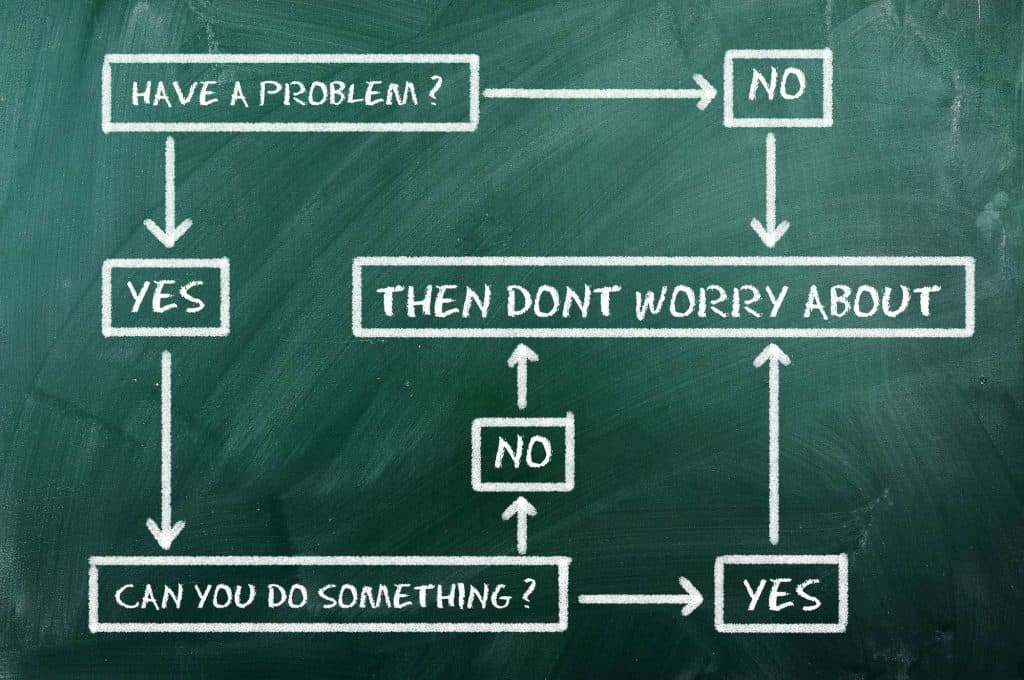
4. Make a list of Pro’s and Con’s for Mental Clarity
Do you have a tough decision to make? Are you unsure of what to do and it’s stressing you out?
This is another pen and paper strategy.
- Begin by making a vertical line down a sheet of paper. One side is where you will list the pros or positives of the situation and the other side is for the cons or negatives.
- This can be a very black-and-white way of looking at something and can help you with making a more objective decision.
- If this is an emotionally charged topic, then it can be helpful to make your list of pros and cons and then step away from it for a little while. You can revisit it later when you’ve calmed down to be sure you’re thinking objectively and clearly.

5. Talk it Out for More Support from Overactive Thinking
Sometimes talking to someone can help put things into perspective.
Just be sure to talk to someone who supports you, like a close friend, family member, therapist, coach, or even a pet.
When you hear yourself say things out loud and put your thoughts and feelings into spoken words, it offers you another avenue to sort through what’s bothering you.
Plus, by having another person to bounce ideas off of you might find a solution much faster than if you continued to try to figure things out on your own. Or, you might realize that your thoughts don’t have a solution and can be dismissed altogether!

And no, I wasn’t joking about talking to a pet. My cat is a very good listener! And, I often do feel much better when we have our little chats.
6. Take Action and Make a Plan to Help Ease Racing Thoughts
If you’ve made a list, done a brain dump, or you’ve talked it out with someone then the next step might be to take action.
- Of the items you’ve listed or spoken about, that are within your control, decide what you’d like to take action on first.
- What steps can you take right now or today? If, it’s feasible, start there!
- What action steps can you take within the next day, week, or month?
Make a step-by-step plan and break it down very clearly. This way you know exactly what you’ll be doing along the way. This plan can be your road map so you feel better about the situation and more in control of the outcome.
So, break it down and then break it down some more until you feel like that first step is manageable! Tiny steps are way better than no steps, right?
ADHD Tip: I rely heavily on the strategy of breaking down large tasks into smaller chunks to reduce overwhelm. Otherwise, I fall back on avoidance and procrastination behaviors, which just compounds my stress and perpetuates the cycle of overthinking. You can print your own FREE Guide to Stop Overthinking so You Can Relax and in it, you can write out your own personalized action plan!
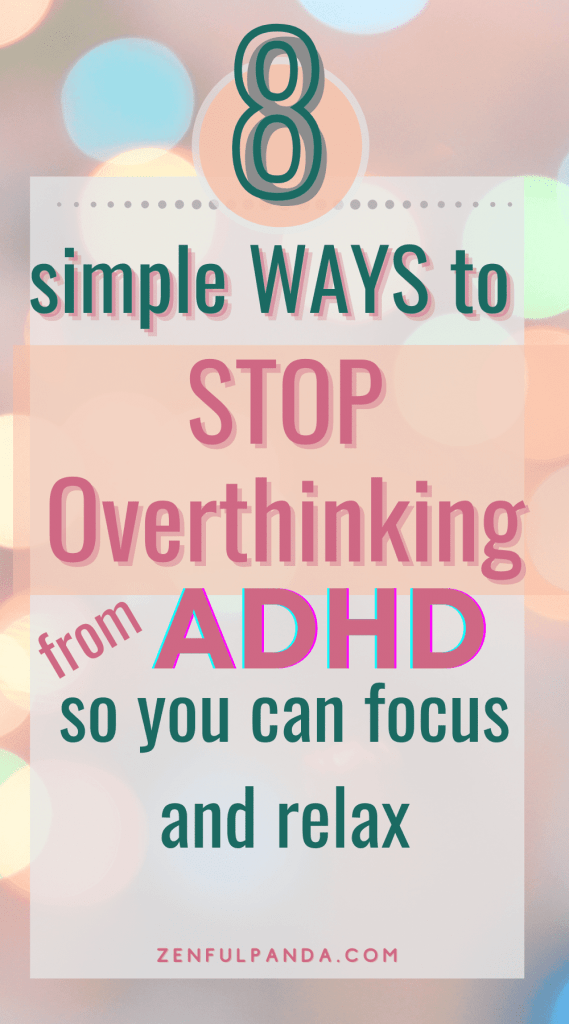
7. Meditate or Practice Mindfulness to Help Stop Constant Stress and Worry
If taking action isn’t a “next step” to overwhelming thoughts or constant worry, then a brief mindfulness break or meditation may be helpful.
To be honest, I used to think meditation was only for yogis and monks.
But, once I took my first MBSR (mindfulness-based stress reduction) class, I was hooked! The calm centered feeling that swept over me as the MBSR teacher led us through meditation brought tears to my eyes.
I think I got emotional because I finally discovered that there was a way to quiet the constant judgy chatter of my “monkey mind.” It opened the door to a tool that I now use almost daily to help manage my ADHD symptoms.
If you’re totally new to mindfulness and meditation, the most important thing to know is that anyone at any level can do it.
Even my first grader knows how to practice mindfulness when he’s feeling anxious, hurt, or stressed. It’s something I wish I had known about when I was younger and struggled with regulating my emotions.
You may be wondering what on earth is mindfulness?
Simply put, being mindful is the practice of being fully present in the current moment without judgment.
The “without judgment” part is what trips most people up, especially if your thoughts are negative or worrisome. It’s hard NOT to judge or react to the stuff in your head, right?
Sometimes I imagine a mini judge sitting up in my brain with her little gavel, just waiting to pass judgment on everything I do!
That’s where having a mindfulness practice comes in super handy. It shuts her right up!

As I mentioned earlier, in the deep breathing exercise, try to just notice each thought as an observer.
Acknowledge the thought and then set it free and bring your awareness back to the present and return your focus to your breath. If you can do this, then you’re practicing mindfulness!
There are many types of mindfulness meditation practices. So, choose what feels best for you and start there.
Here are 4 Examples of Mindfulness to Help Get You Started. Even if you have ADHD!
- Acknowledge Bless and Release Meditation
- Mindfulness Music Meditation
- Walking Meditation for Stress-Reduction
- The 5 Senses Mindful Meditation Practice
All of these exercises are beginner friendly so you can try them out right away. I’ll discuss each one in more detail below.
Acknowledge Bless and Release Meditation for Dealing with Negative Thoughts
I use an “Acknowledge, Bless, and Release” approach if my thoughts are particularly unhelpful.
If you find yourself listening to constant negative self-talk, then try this! It might seem silly and you might feel a little ridiculous while you’re doing it, but it works.
For example, if I had the following thoughts, “You failed again at meal planning this week. You ate too much fast food. It’s no wonder you feel terrible…Serves you right.” and on and on it goes.
These are the steps for dealing with negative self-talk.
- I first Acknowledge the thought. I say something like, “Oh, hello there Negative Nelly!”
- Then, I Bless the thought for trying to protect me and make me better. I say, “Thank you for trying to help, but I’ve heard enough.”
- And then, I Release the thought as if it’s a helium balloon and Let It Go! I might even say, “Bye-Bye! Adios! Don’t come back!”
Once you try this, you’ll realize just how satisfying it is to dismiss negative thoughts this way! Seriously, give it a whirl – you’ll see.
But, if the negative thoughts come back, repeat the process again as needed.
Sometimes it takes a few tries before Negative Nelly gets the hint that she’s not wanted.
Mindfulness Music Meditation
Music is a powerful tool for shifting your mindset and mood.
- If you’re feeling upset and overwhelmed then listening to some relaxing music with your eyes closed might help ease your mind.
- Allow your mind to focus on the tones, notes, beat, and feeling of the music.
- And, if your mind wanders, just bring it back to the music. You may have to redirect your attention to the music multiple times, but just tune back into the sounds without judgment each time.
Tip: Create a playlist of your favorite songs to make it easier to get lost in some chill music when you’re having a hard time.
I’d love to know what some of your favorite go-to songs are for when you’re stress or anxious! Please share in the comments below.
Walking Meditation for Stress-Reduction Beginner Friendly Mindfulness
If you need a change of scenery or if you just need to get outside, then you could try doing a walking meditation.
- As you walk just notice the sights and sounds around you. Bringing your attention back to what you experience as you walk, rather than giving your worrisome thoughts space in your mind.
- Sometimes counting things you see can give your mind something external to focus on.
- You could try counting how many fire hydrants you see or how many mailboxes there are on the block. You get the idea. Simply, walk and notice without judgment.
You may have noticed I used the word “simply” in the previous sentence. I want to point out that even though the idea is “simple”, it’s not always easy.
A walking meditation may take some time and practice, but go easy on yourself and try not to get frustrated if you have to redirect your thoughts to the present while you’re walking.
If you’re just starting out, try it for just the first 5 minutes of your walk. Sometimes, that’s all it takes to help interrupt racing thoughts or overthinking.
Plus, being outside in the fresh air might be enough to shift your perspective if you allow it to!
If you need more direction, then a guided meditation may help relieve some of your worries. You can listen to this 5 Minute Guided Meditation to Stop Racing Thoughts on the Zenful Panda podcast.
The 5 Senses Mindful Meditation Practice
Seriously, mindfulness doesn’t have to be complicated. It can be as simple as tuning into your five senses.
By noticing what you see, hear, taste, smell, and feel you can shift your focus away from your overthinking mind and into the here and now.
- What do you hear? Is it the whirring of a fan or a dog barking outside?
- What do you feel? Is it the pressure of the chair against your back or the coolness of the air on your skin?
- Give it a try. Start with whatever you notice first and move through each of your five senses slowly and with some detail to help you consciously tune-in to what your body is experiencing at that very moment.
Mom Tip – The 5 Senses Mindfulness Exercise is also a great way to help anxious kiddos get out of their head if they’re worried about something or are stuck in a thought-loop. Ask them what they notice around them or do it together and take turns sharing.
8. Color to Relax and Get Rid of Racing Thoughts from ADHD
You don’t have to be a kid to enjoy coloring.
Many adults have discovered the therapeutic benefits of coloring. Adult coloring books have recently risen in popularity and they’re here to stay! Especially, now that you can find just about any type of coloring book imaginable.
The simple act of coloring in a pattern or image allows your mind to focus on one thing. Coloring can also help displace negative self-talk and overthinking because it balances and calms the brain similar to meditation!

You don’t need much at all to begin coloring for stress relief. You’ll find hundreds of interesting adult coloring books on Amazon for under $5.
The Plant Parent is the coloring book I’m working on now. Yes, I’m a #plantparent with no intentions of slowing down on having more plant babies!
Intrigued or want to give coloring a try? I break down 9 mental health benefits of coloring for you here in this blog post. Plus, you can snag your own FREE coloring pages to print at home!
If you’d like more support or you’re interested in diving deeper, then I have a few options for you.
- Download my FREE Guide How to Stop Overthinking so You Can Relax.
- Stop Overthinking and Start Relaxing with this brief 5 minute guided meditation specifically made to help stop overthinking in its tracks.
- Listen to the Zenful Panda Podcast for more guidance on mindfulness, stress reduction, healthy habits, and wellness tips!
Stressful anxious thoughts are bound to happen to all of us, so don’t beat yourself up or stay stuck and alone in a cloud of chaos. You deserve better.
I’m here to tell you that you can stop overthinking with ADHD by using these 8 simple strategies:
1. Self-Massage
2. Deep-Breathing
3. Brain Dump
4. Make a List
5. Talk it Out
6. Take Action
7. Meditate or Practice Mindfulness
8. Color (print your own FREE Coloring pages here)
I hope you found these tips helpful! Remember, it takes practice and consistency to rewire your brain and overcome anxious thinking. Stick with it and you’ll begin to notice how quickly you can calm down when you tune in to your mind-body-zen connection.
Please let me know in the comments below if you’re a member of the “Overthinkers Club”. How do you like to ease your mind when you’re stressed out or have racing thoughts?


